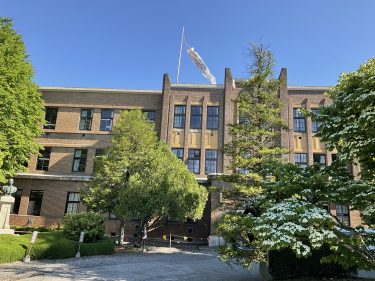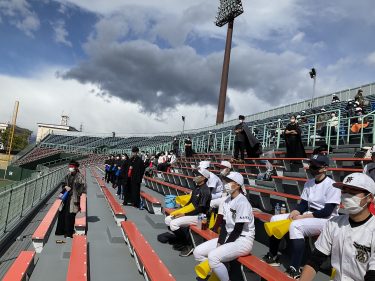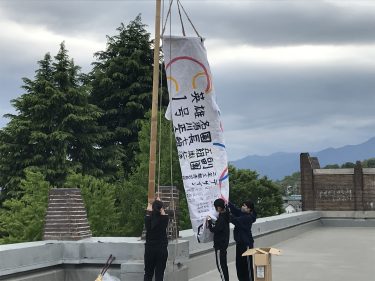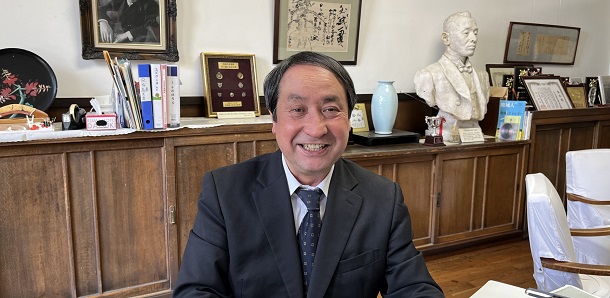第165号 応援団管理委員会のこと
【応援団管理委員会のこと】
縁の下の力持ちという表現がある通り、この世の中には何かの基礎を作ったり支えたりする仕事や役目が多くあります。そして往々にしてあまり表舞台には出てきません。
本校の応援団管理委員会もどちらかというとそのタイプに分類できるかもしれません。
そもそも応援団とは、様々な行事や大会で応援をする人たちの集まりのことですが、応援団を統率する委員会を本校では「應援團管理委員會」と呼び、旧字体を用いています。いわゆる常設の執行機関としての図書委員会などとはやや性格を異にし、どちらかというと、吹奏楽部やサッカー部といった部活動の一つに似ているかもしれません。
新入生の応援練習を行う姿が春先のニュースに時々登場する応援団ですが、実際にはどんな活動をしているのか、どんな思いで活動しているのかを現在の「団長」(応援団管理委員長)の名須川君に聞いてみました。

「活動としては、野球の応援、クラブの壮行会、対面式、1年生への歌の練習があります。また、あまり目立たない活動ですが、とんぼ祭でのアーチ作り、ファイヤーストームの進行などをしており、さらに大体育館周辺の側溝清掃や冬場は鯉のぼり作りもしています。
現在は、コロナ禍で思うような活動はできませんが、できることを全力でやっています。一番辛いのは、野球の応援に行っても声を出すことができないので、応援の仕方を変えなくてはいけないことです。」

今も面々と続いている活動の一つが「鯉のぼり」作りで、5月中は正面校舎の屋上で気持ちよさそうに泳いでいます。大きさは3メートルを超えるもので、毎年冬に新しい鯉を作り、胴体には団員の名前などとともに校長の名前が入ります。私の名前は塩野英雄。そこで、今年の鯉の名前は「英雄1号」

団長の名須川くんは続けていいます。
「今の2年生団員は、新型コロナウイルスの影響で全てを体験しているわけではないので、いろんなことを伝えていかなくては、と思っています。
ただ、伝統を引き継ぐのも大事ですが、時代に合わせて変えていってもいいのではないかと思っています。例えば、スマホでも応援ができる時代だから、歌の練習も変えてもいいかもしれません。
伝統を守ることがすべてではなく、何をすることが深志生の役に立つかを考えて活動していく時代だと思います。変えるものは変え、守るべきものは守る。逆に新しいものを作るチャンスかもしれません。後輩には、より良い姿を探していってほしいと思います。」
鯉のぼりの制作だけでも探究課題になるくらい、応援団管理委員会の歴史は長く深いものがありますが、団長の言葉通り、よい形で活動が続いていくことを願っています。
かつての団長であり、現在は松本市にある通信制高校の校長を務める 水野好清さん(26回・65歳)から当時の様子をお聞きしたところ、活動内容は現在とそう変わらなかったようですが、最後に次のような逸話をお聞きしました。
「余談ではあるが、3学期の始業式に合わせてクロ(犬)の葬式を、応管が中心となって先生にも掛け合って実現したが、なぜ応管が中心であったのかは定かではない。決まりがないものを引き受けるのが応管の役割だったように思う。」と。
応管は、当時から「縁の下の力持ち」的な存在だったようです。
(クロについては、以下の同窓会HPからどうぞ)
https://www.fukashi-alumni.org/kuro/
(English version below)
Some of you may have heard the phrase “an unsung hero (heroine),” meaning somebody working for others behind the scenes, not on the stage.
Our cheering team could be classified as such. Naturally the cheering leader is one that brings together the students to cheer the players in sports, but the team in our school carries out their activities just as normal school clubs do.
The leader of the cheering squad, Mr. Nasukawa, says,
“What we do in a year includes to cheer at the ball stadium, to give players a send-off party, to have a ceremony to introduce freshmen to their seniors as well as a school song practice. Other activities of theirs draw little attention: to build an arch at the school gate and conduct a bonfire at the school festival, to clean the gutters around school, and to make a carp streamer in winter.
(Actually, the very carp streamer more than three meters long they had made in winter was swimming in the air on top of the school building in June, with the names of the team members and the principal on it.)
“Under the restricted environment due to the virus, we do what we are able to do now. The hardest thing is that we cannot sing out loud to cheer in the ball stadium.
“I think that I need to tell the role as a cheering team to the juniors, who haven’t fully experienced the jobs under the virus so far.
“To observe tradition is important in a sense, but it varies across the times. You could change the way you teach school songs to freshmen in this Internet age.
“Now is the time when you try to do what you think will be of use to the fellow students, not that tradition is everything. Sometimes stand on tradition, sometimes step out of it. You could invent something new. I hope that my juniors will find their own way.”
The history of the cheering group in our school dates back to a long time ago; the former cheerleader about 50 years ago, Mr. Mizuno, the principal at a high school with correspondence course in Matsumoto, remembers his days and mentions,
“What the cheering students do now looks like what we did back in the 1970s. One episode I could add is that we gave a funeral to a dog named Kuro which had stayed at school so long. (I doubt if it was our requisite job.)”
They seemed to play the behind-the-scenes role in those days as well.


